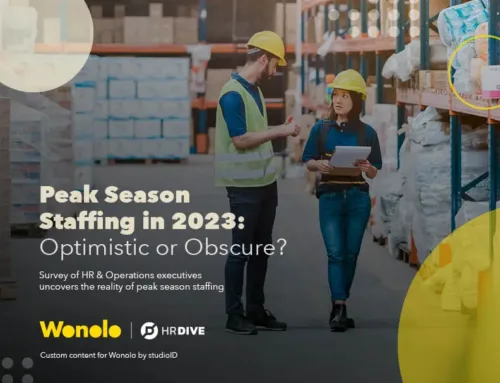Wonolo
It seems like everyone is talking about the on-demand economy, a form of work in which workers connect with clients to perform tasks as needed on a (typically) temporary basis. Here’s a look at the on-demand economy, how it works, and how you can participate in the on-demand economy to earn a living or boost your existing income.

Definition of the On-Demand Economy
The on-demand economy is defined as the economic activity created by digital marketplaces and technology companies to fulfill consumer demand via immediate access to goods and services. The on-demand economy is also sometimes referred to as the “access economy,” and provides a convenient way to provision goods and services to those who are in the market for them. There are thousands of companies currently making use of the on-demand economy.
With consumer behavior changing to prioritize fast, simple, and efficient experiences, the on-demand economy is growing at an unparalleled pace. Convenience, speed, and simplicity are at the top of the priority list for consumers looking to have their needs met. The ease of filling spare time and picking and choosing one’s hours is also appealing to those with skills to meet growing consumer demand.
How the On-Demand Economy Works
The on-demand economy works by taking a service, such as meal delivery, hairstyling and makeup application, or handyman repairs, and using technology in order to connect suppliers with consumers.
This connection usually happens through a technological service such as a website or smartphone application, with both parties signing up for accounts in order to use the service. Then, when a customer is in need of a service, they open the app, input their parameters, and send a request to connect with a service provider.
The service provider is then alerted through the application of the service request and heads out to perform the task for the consumer. Upon completion of the service, payment typically takes place through the technology company. This ensures that there is no sharing of personal information between parties — as the technology company acts as an intermediary and safeguarder of personal information. Following service, both parties are prompted to provide feedback and ratings for one another, in order to improve the system and ensure the quality of service.
Examples of the On-Demand Economy

Many of the popular services people use on a regular basis nowadays are examples of the on-demand economy. Ride-sharing platforms Uber and Lyft, as well as grocery delivery services such as InstaBuggy and InstaCart are just some examples of services within the on-demand economy.
The on-demand economy is comprised of services in all digitally-based marketplaces — primarily mobile — that provide access to and/or fulfillment of goods and services.
Industries that utilize the on-demand economy include business services, travel, education, delivery, shipping, parking, subscription, pet care, family care, home services, transportation, health & beauty, reservations & ticketing, and P2P goods. There are hundreds, if not thousands of companies currently making use of the on-demand economy, and more and more companies are popping up to meet this demand every month.
Benefits of the On-Demand Economy
There are many benefits to the on-demand economy, chiefly the real-time fulfillment of goods and services, and the ease and convenience of finding a skilled service provider to meet one’s needs.
Businesses prefer the on-demand economy for a number of reasons. First, it allows them to satisfy the needs of consumers in a cost-effective, scalable, and efficient way. It also allows them to offer services and realize astounding levels of profit, without all the overhead costs associated with traditional labor models. There is no staff to hire, train, or provide benefits for, and since work is often service-based, there are no costs associated with materials. The service provider assumes the direct day-to-day operating costs of the business, while the company maintains the technological network.
One downfall of the on-demand economy for businesses is the requirements to maintain and ensure user privacy. With hacking attempts in the news, it’s clear that more needs to be done in this area. Preventing cyber attacks can be an expensive cost, but it is essential for consumer trust.
For those providing services, the on-demand economy allows them to use their spare time in order to generate additional income. People can choose to work as much or as little as they want, and can often be paid out the same day for services rendered. Workers also don’t have to worry about sourcing and qualifying customers, as the app is designed to provide a steady supply of requests.
One negative aspect of the on-demand economy for service providers is that there is no way to guarantee a set amount of work. This can make budgeting difficult. Another challenge is that service providers are considered independent contractors for the sake of employment income, and as such will need to file and remit their own taxes, which can become complicated if they are working with multiple companies.
Best Practices for Participating in the On-Demand Economy
For companies, ensuring that users experience a frictionless interface is of the utmost priority for meeting consumers’ insatiable appetite for greater simplicity and convenience.
For users, best practices include safeguarding personal information, as well as participating fairly in review and rating systems. Keeping the playing field fair for both sides through honest and fair feedback is a crucial part of the on-demand economy system.
For service providers, it is important not to overstate qualifications, and to provide a level of service you would like to receive. Again, like consumers, it is best practice for service providers to participate in review and rating systems honestly and fairly.
The on-demand economy is here to stay and represents one of the quickest and largest growing commerce sectors since the advent of Internet commerce. As consumers look for more convenience, speed, and simplicity for the tasks in their lives, service providers will continue adapting in order to meet their needs. Sooner than we realize, we’ll be able to satisfy nearly every need or desire with just the tap of a button, no matter where we are.


![[Report] Beyond the Gig: Exploring Reliable Work Options for the Modern Workforce](https://info.wonolo.com/wp-content/uploads/2023/10/Worker-Preferences-Report-Header-Image-500x383.png)



